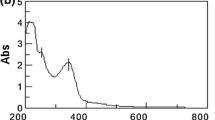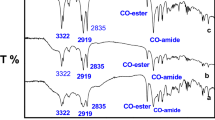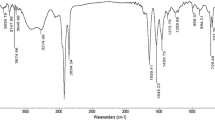Abstract
In this article we show steps taken toward the development of bactericidal and fungicidal synthetic cationic surfactants by the reaction of decyl, dodecyl or tetradecyl amine with selenious acid to produce a series of quaternary ammonium salts which consequently converted to copper and cobalt cationic complexes via complexing them with copper (II) or cobalt (II) ions. Surface properties of these surfactants were investigated. The surface properties studies included critical micelle concentration (CMC), maximum surface excess (Γmax) and minimum surface area (A min). Free energy of micellization ( \( \Updelta G^{0}_{{{\text{mic}}}} \)) and adsorption (\( \Updelta G^{0}_{{{\text{ads}}}} \)) were calculated. The antimicrobial activity was determined via the inhibition zone diameter of the prepared compounds measured against five strains of a representative group of microorganisms. FTIR spectra, elemental analyses and 1 H-NMR spectra were obtained to insure the purity of the prepared compounds






Similar content being viewed by others
References
Edmonds JS, Morita M (2000) Synthesis, structure and cytotoxicity of organoammonium selenites. Appl Organomet Chem 14:133
Gellman SH, Petter R, Berslow RJ (1986) Catalytic hydrolysis of a phosphate triester by tetracoordinated zinc complexes. Am Chem Soc 108:2388
Tagaki W, Ogino K, Tanaka O, Machiya K, Kashihara N, Yoshida T (1991) Hydrolytic metalloenzyme models. Micellar effects on the activation of the hydroxyl groups of N-alkyl-2-(hydroxymethyl)imidazole ligands by Cu2+ in the transacylation of p-nitrophenyl picolinate. Bull Chem Soc Jpn 64:74
Menger FM, Gan LH, Johnson E, Durst DH (1987) Phosphate ester hydrolysis catalyzed by metallomicelles. J Am Chem Soc 109:2800
Lippard SJ, Beg JM (1994) Principles of bioinorganic chemistry. University Science Books, Mill Valley
McDonnell G, Russell AD (1999) Antiseptics and disinfectants: activity, action, and resistance. Microbiol Clin Rev 12:147
Oren Z, Hong J, Shai YJ (1997) A repertoire of novel antibacterial diastereomeric peptides with selective cytolytic activity biol. Chem 272:14643
Arsenyan P, Shestakova I, Rubina K, Domracheva I, Nesterova A, Vosele K, Pudova O, Lukevics E (2003) Organoammonium hydroselenites: antitumor action through radical balance regulation. Eur J Pharmacol 465:229
Gulya AP, Rudik VF, Shova SG, Gudumak VS, Kokunqv YV, Denchikova LA (1992) Cobalt (II) hydroselenite (2-water). Patent SU1726371
Badawi AM, Mekawi MA, Mohamed AS, Mohamed MZ, Khowdairy MM (2007) Surface and biological activity of some novel cationic surfactants. J Surfactants Deterg (in press)
Findlay (1963) Practical physical chemistry, 6th edn. Longman, London, p 92:101
Hampson JW, Cosnell DG (1996) Surface-tension properties of some poly dispersed alkyl-substituted polyoxy-ethylated phenyl sulfonamides. J Am Oil Chem Soc 73:891
Takeshita TI, Shimohara W, Maeda S (1980) Surface-tension properties of some poly dispersed alkyl-substituted polyoxy-ethylated phenyl sulfonamides. J Am Oil Chem Soc 57:9430
Takeshita TI, Wakebe S, Maeda S (1982) Synthesis of EDTA-monoalkyl amide chelates and evaluation of the surface-active properties. J Am Oil Chem Soc 59:90
Bhattacharyya DN, Kelkar RY, Almeida MR, Das AK, Chikhale SV (1994) Tenside surfactants detergents, Carl Hanser Publisher, Munich, vol 31, 41, pp 260
Rosen MJ (1987) Surfactants and interfacial phenomena. Wiley, New York, p 72
Ammona S, Mohamed, Magdi M, Wad BA (2003) Synthesis and surface properties of some dyestuff esters. Mater Sci Res India I:59
Grayer RJ, Harbone JB (1994) A survey of antifungal compounds from higher plants. Photochemistry 37:19
Irob ON, Moo-Young M, Anderson WA (1996) Antimicrobial activity of annato extract. Int J Pharmacog 34:87
Jawetz E, Melnick JL, Adelberg EA (1974) Review of medical microbiology. Lang Medical Publication, Los Altos
Muanza DN, Kim BW, Euler KL, Williams L (1994) Antibacterial and antifungal activity of nine medical plants from Zaire. Int J Pharmacog 32:337
Rutherford PE, Thornton DA (2001) Spectro Chim Acta 29A
Gad EAM, El-Sukkary MMA, Ismail DA (1997) Surface and thermodynamic parameters of sodium N-acyl sarcosinate surfactant solutions. J Am Oil Chem Soc 74:43–47
Lourdes P, Josep LT, Angeles M, Conxitra S, Rosa MI (1996) Synthesis and biological properties of a new class of gemini cationic amphiphilic compounds from Arginine, bis(Args). Langmuir 12:5296
Yashiro M, Matsumoto K, Seki N, Yoshikawa S (1993) Preparation of Cobalt (II) and Nickel (II) complexes having an alkyl long chain and their surface tension reducing abilities. Bull Chem Soc Jpn 66:1559
Przestalski S, Sarapuk J, Kleszcznska H, Habrielska J, Trela Z (2000) Kuczera Influence of amphiphilic compounds on membranes. J Acta Biochem Pol 47(3):627
Brunt KD (1987) Biocides for the oil industry. In: Hill HC (ed) Wiley, New York, p 201
Hugo W, Snow G (1981) Biochemistry of antibacterial action. Chapman and Hall Ltd., London
Marcozi, Di-Domenico C, Spreti N (1998) Effects of surfactants on the stabilization of the bovine lactoperoxidase activity. Biotech Prog 14(4):653
Birnie CR, Malamud D, Schnaare RL (2000) Antimicrobial evaluation of N-alkyl betaines and N-alkyl-N,N-dimethylamine oxides with variations in length. Antimicrob Agents Chemother 44:2514
Campanac C, Pineau L, Payard A, Baziard-Mouysset G, Roques C (2002) Interactions between biocide cationic agents and bacterial biofilms. Antimicrob Agents Chemother 46:1469
Tomiki I, Hiroki H, Hideki Y, Shigeo T, Michio W (1986) Polycationic biocides with pendant active groups: molecular weight dependence of antibacterial activity. Antimicrob Agents Chemother 30:132
Badawi AM, Negm NA, El-Zahar SM (2004) Biocidal activity of some novel cationic metallomicelles. Met Ions Biol Med 8:89
Author information
Authors and Affiliations
Corresponding author
About this article
Cite this article
Badawi, A.M., Mekawi, M.A., Mohamed, M.Z. et al. Surface and Biological Activity of Organoammonium Hydrogen Selenite Surfactants. J Surfact Deterg 10, 257–267 (2007). https://doi.org/10.1007/s11743-007-1041-7
Received:
Accepted:
Published:
Issue Date:
DOI: https://doi.org/10.1007/s11743-007-1041-7




